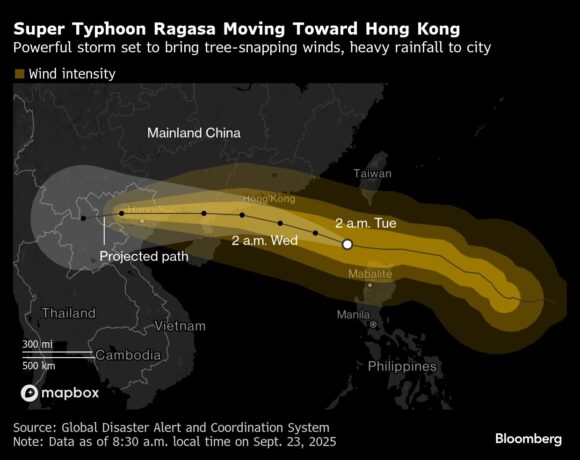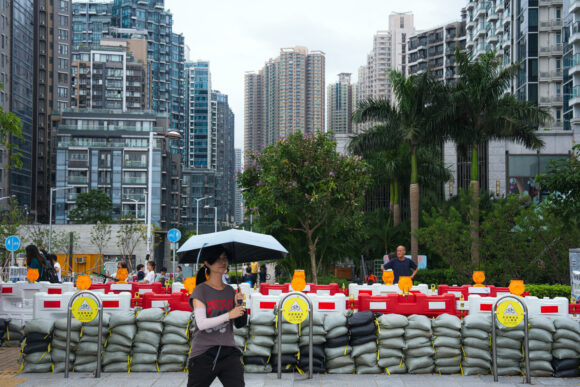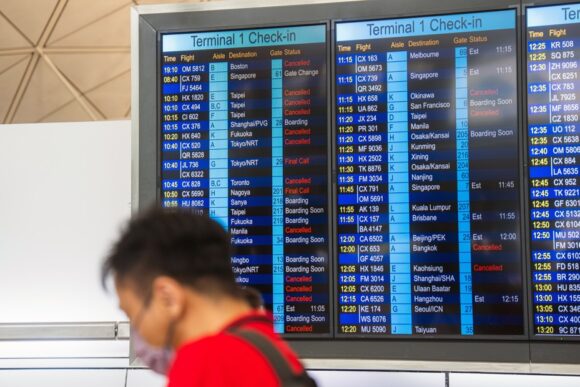Hong Kong is facing a night of destructive winds and drenching rain as Super Typhoon Ragasa tracks toward the financial hub, potentially becoming the most damaging storm since Mangkhut in 2018.
The typhoon weakened slightly on Tuesday as it moved through the South China Sea. The storm is packing top sustained winds of 205 kilometers (127 miles) per hour, according to the Hong Kong Observatory, which is equivalent to a Category 3 hurricane on the five-step Saffir-Simpson scale. The system was 290 kilometers southeast of the city as of 7 p.m. local time.
Ragasa has already caused major flight disruptions, and suspension of school classes and business activities across southern China after skirting the northern Philippines on Monday. The weather bureau has issued its third-highest storm warning, and is assessing the need to raise it further, potentially to the highest level.

The current storm warning level in place is dubbed signal No. 8, while the most severe alert, known locally as a T10, means hurricane-force winds are present or expected. The weather will be “persistently adverse” on Wednesday, with gale- to storm-force winds prevailing, the Hong Kong Observatory said.
The core of the storm is tracking south of Hong Kong, but widespread disruptions are expected from heavy rains, destructive winds and punishing waves over the next 24 hours, said Adam Douty, a meteorologist with commercial-forecaster AccuWeather Inc.
“It should pass south of Hong Kong and Macau, but they will certainly get into the storm,” he said.

Ragasa has already forced online some conferences and forums scheduled for Wednesday and Thursday, including a gathering on fixed income and currencies, while several delegates have pulled out of an aviation conference. Loan bankers also rushed to get paperwork physically signed to keep deals moving along.
In 2018, Mangkhut brought damaging winds and record-breaking storm surges to Hong Kong, with the weather agency estimating it caused total economic losses including insurance claims of HK$4.6 billion ($592 million). The city may see a similar storm surge from Ragasa, according to forecasters.
“The only thing that will stop this storm is land,” the US Navy’s Joint Typhoon Warning Center said in an earlier advisory.

Passenger flights in and out of Hong Kong will be suspended for 36 hours from 6 p.m. local time on Tuesday. Almost 50% of the 1,098 passenger and cargo flights due to depart and arrive at the airport today have already been axed, according to data compiled by Webb-site.com.
Airports in Shenzhen and Macau will also close for an unspecified period, and all rail services in China’s Guangdong province will be suspended on Wednesday. Cities including Zhuhai, Jiangmen and Foshan — the country’s “aluminum capital” — also suspended classes and work.

Across Hong Kong, businesses and residents are taking steps to prepare, with some grocery stores cleared of food items such as fresh vegetables. Many shop and apartment windows are also taped up with giant X’s, a practice thought to protect against flying debris, but a measure the US National Oceanic and Atmospheric Administration says is a waste of time and tape.
In Taiwan, thousands of households lost power, and offices and schools were closed in some southern cities, while nearly 25,000 people were evacuated across the Philippines’ main Luzon island. Ragasa skirted the northern part of the archipelago and is now churning in the South China Sea.
The storm is expected to weaken as it tracks toward Vietnam after clipping southern China, and the Southeast Asian nation has put more than 300,000 military personnel, 8,000 vehicles and six aircraft on standby for the cyclone.
Landfall is expected near Zhanjiang early Wednesday in New York time, Douty said. After that, the storm’s remnants are expected to move into northern Vietnam, bringing torrential rains and possible flooding and landslides to Hanoi and Laos, he said.
Related:
- Super Typhoon Lashes Philippines on Track Toward Hong Kong
- Hong Kong Boosts Flood Management as Climate Change Fuels Heavy Rains
Topics Catastrophe Natural Disasters
Was this article valuable?
Here are more articles you may enjoy.


 Trump Administration Turning to Private Firms in Cyber Offensive
Trump Administration Turning to Private Firms in Cyber Offensive  Chubb, The Hartford, Liberty and Travelers Team Up on Surety Tech Launch
Chubb, The Hartford, Liberty and Travelers Team Up on Surety Tech Launch  Abbott Presses Congress for Legal Shield Over Preemie Baby Formula Lawsuits
Abbott Presses Congress for Legal Shield Over Preemie Baby Formula Lawsuits  After Years of Pushing Rate Hikes, Florida’s Citizens Now Wants HO Rate Decrease
After Years of Pushing Rate Hikes, Florida’s Citizens Now Wants HO Rate Decrease 

